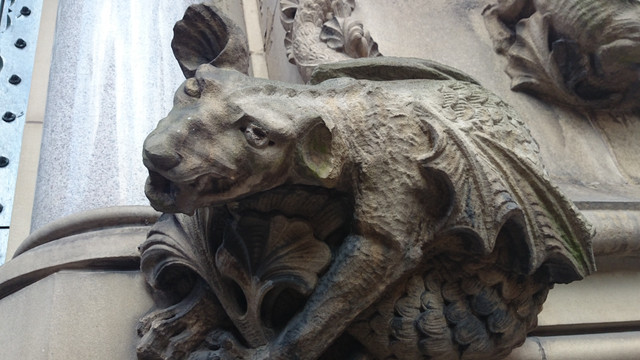To log this cache you must email/ message centre me answers to the following:
I'm a Friendly CO - please try and answer the questions, and have a bit of fun whilst doing it. That said, no answers = no log (and I will delete it)
1. Take a photo at GZ with a Minshull Street Monster, preferably with you or your GPS in it (optional, but nice evidence of your visit here)
Please answer the following Questions: 2. (a) Can you observe any evidence of weathering? If so, please describe it.
2. (b) Can you describe what the Monsters look and feel like – are they rough or smooth, can you see any damage? If so, please describe it.
3. Excluding the antelope and lion above the magistrates’ door, how many doorway ‘monsters’ are there around the four entrances? (So, around the WHOLE building)
4. Why would Yorkstone/ Sandstone have been used for the carvings?
Please don’t include answers in your log, send them to me. Logs posted without the accompanying email will be deleted
Metered Parking is available on Minshull Street, close to GZ, and it is wheelchair friendly, although this street is surprisingly busy, so please take care if you have mini or furry geocachers with you.
This location has personal interest for me as the street has the same name as my family name, and this has been ‘placed’ for my mums’ birthday.
The original building was known as The City Police Courts, and was constructed between 1867 and 1873 to a design by architect Thomas Worthington. Worthington had failed to secure the design for Manchester Town Hall and he drew upon that design and others when creating this building. Worthington was noted for his European Gothic style and his adoption of Ruskinian principles, and this building is no different. The buildings were modernised between 1993 and 1996 when a glazed roof was added to the courtyard and an extension was added to the Aytoun Street side, which has become the main public entrance into the building.
Asymmetrical in composition, dominant features are an impressive corner tower and a chimney stack styled as a campanile (Italian bell tower), thought to have been inspired by Worthingtons’ travels in Italy and the sketches he made there. In the centre of the complex there were 4 courtrooms, surrounded by ancillary rooms for security and to keep out noise from the city streets. There are tall ordered rows of windows fronting the streets, and although the outside of the building is generally sparse in decoration, carvings of spikey gargoyles by Earp and Hobbs adorn the stonework in the chimney and the clock tower. Perched on finials high above the Bloom Street side of the building are carved owls, while stone a lion and antelope prowl the gables above the Magistrates’ entrance. GZ is at the justices/ magistrates doors, opposite Richmond Street.
When originally built there were separate entrances for the public and justices, resulting in four sets of doors, two on Minshull Street and two on Bloom Street. There are also columns of polished granite (visit GC5EEZJ "Euhedral Crystals" for a local and brilliant earthcache about granite) which pale in to comparison once you see the most impressive carving here in the form of fierce monsters which flank each side of the doors. These monsters are arranged in pairs and are all different in detail, individually writhing and skulking with their gruesome, contorted faces.
![Monster!]()

A municipal project which cost £81,000, financial limitations meant that stone could not be used exclusively for the facades as seen on other buildings like the Town Hall, and the original building is a mixture of red brick with pale golden Yorkshire stone dressings, and it is the Yorkshire stone which will be the focus here. Much of the impressive visual effect here is the contrast of red brickwork against the pale stone dressings and blue slate roof.
Yorkshire Stone – or Yorkstone – is a variety of sandstone, specifically from quarries in York, although there is no actual definition of Yorkstone. Yorkstone is a tight grained, Carboniferous sedimentary rock. The stone consists of quartz, mica, feldspar, clay and iron oxides. Known for being hard wearing, reasonably weather resistant, and durable, Yorkstone has been used in a wide array of buildings and other applications around the world for many years. In Yorkshire, split stones called thackstone (Scots thack, English thatch) have been used as roofing, and the traditional London paving stone has been York stone.
Sandstone (sometimes known as arenite) is a clastic sedimentary rock composed mainly of sand-sized minerals or rock grains which are geologically cemented together. Most sandstone is composed of quartz and/or feldspar because these are the most common minerals in the Earth's crust. Like sand, sandstone may be any colour, and is commonly found tan, brown, yellow, red, grey, pink, white and black. Since sandstone beds often form highly visible cliffs and other topographic features, certain colours of sandstone have been strongly identified with certain regions.
The formation of sandstone involves two principal stages. First, a layer or layers of sand accumulates as the result of sedimentation, either from water (as in a stream, lake, or sea) or from air (as in a desert). Once the layers have accumulated, the sand becomes compacted by pressure of overlying deposits and cemented by the precipitation of minerals within the pore spaces between sand grains.
Sandstone has been a popular building material from ancient times. It is relatively soft, making it easy to carve and has been widely used around the world in constructing temples, homes, and other buildings. It has also been used for artistic purposes to create ornamental fountains and statues. Some sandstone is resistant to weathering yet easy to work, which makes sandstone a common building and paving material (including in asphalt concrete). Because of the hardness of individual grains, uniformity of grain size and friability of their structure, some types of sandstone are excellent materials from which to make grindstones, for sharpening blades and other implements. Non-friable sandstone can be used to make grindstones for grinding grain, e.g., gritstone.
Information sources:
“Public Sculpture of Greater Manchester” Terry Wyke with Harry Cocks
“Manchester” Clare Hartwell
“Art and Architecture in Victorian Manchester” edited by John H G Archer
Wikipedia – Sandstone & Yorkstone
